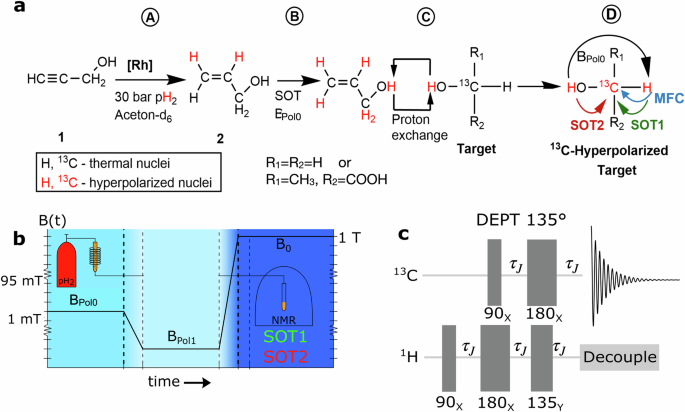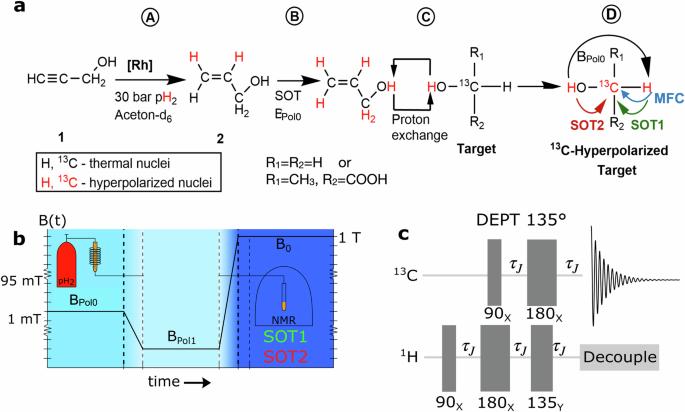Nuclear spin polarization of lactic acid via exchange of parahydrogen-polarized protons
IF 5.9
2区 化学
Q1 CHEMISTRY, MULTIDISCIPLINARY
引用次数: 0
Abstract
Hyperpolarization has become a powerful tool to enhance the sensitivity of magnetic resonance. A universal tool to hyperpolarize small molecules in solution, however, has not yet emerged. Transferring hyperpolarized, labile protons between molecules is a promising approach towards this end. Therefore, hydrogenative parahydrogen-induced polarization (PHIP) was recently proposed as a source to polarize exchanging protons (PHIP-X). Here, we identified four key components that govern PHIP-X: adding the spin order, polarizing the labile proton, proton exchange, and polarization of the target nucleus. We investigated the last two steps experimentally and using simulations. We found optimal exchange rates and field cycling methods to polarize the target molecules. We also investigated the influence of spin relaxation of exchanging protons on the target polarization. It was found experimentally that transferring the polarization from protons directly bound to the target X-nucleus (here 13C) of lactate and methanol using a pulse sequence was more efficient than applying a corresponding sequence to the labile proton. Furthermore, varying the concentrations of the transfer and target molecules yielded a distinct maximum 13C polarization. We believe this work will further help to understand and optimize PHIP-X towards a broadly applicable hyperpolarization method. Hyperpolarization has become a powerful tool to enhance the sensitivity of NMR analyses, whereby hydrogenative parahydrogen-induced polarization with exchanging protons could broaden its applicability. Here, the authors identify four key components that govern the polarization of exchanging protons, and propose optimal exchange rates and field cycling methods to polarize target molecules.


通过对氢极化质子的交换实现乳酸的核自旋极化。
超极化已成为提高磁共振灵敏度的有力工具。然而,使溶液中的小分子超极化的通用工具尚未出现。为此,在分子间转移超极化的易变质子是一种很有前景的方法。因此,最近有人提出将氢化对氢诱导极化(PHIP)作为极化交换质子(PHIP-X)的来源。在这里,我们确定了支配 PHIP-X 的四个关键组成部分:添加自旋阶、极化可变质子、质子交换和目标核的极化。我们通过实验和模拟研究了最后两个步骤。我们找到了使目标分子极化的最佳交换率和场循环方法。我们还研究了交换质子的自旋弛豫对目标极化的影响。实验发现,使用脉冲序列从直接与乳酸盐和甲醇的目标 X 核(此处为 13C)结合的质子转移极化比对可变质子使用相应的序列更有效。此外,改变转移分子和目标分子的浓度会产生不同的最大 13C 极化。我们相信,这项工作将有助于进一步了解和优化 PHIP-X,使其成为一种广泛适用的超极化方法。
本文章由计算机程序翻译,如有差异,请以英文原文为准。
求助全文
约1分钟内获得全文
求助全文
来源期刊

Communications Chemistry
Chemistry-General Chemistry
CiteScore
7.70
自引率
1.70%
发文量
146
审稿时长
13 weeks
期刊介绍:
Communications Chemistry is an open access journal from Nature Research publishing high-quality research, reviews and commentary in all areas of the chemical sciences. Research papers published by the journal represent significant advances bringing new chemical insight to a specialized area of research. We also aim to provide a community forum for issues of importance to all chemists, regardless of sub-discipline.
 求助内容:
求助内容: 应助结果提醒方式:
应助结果提醒方式:


